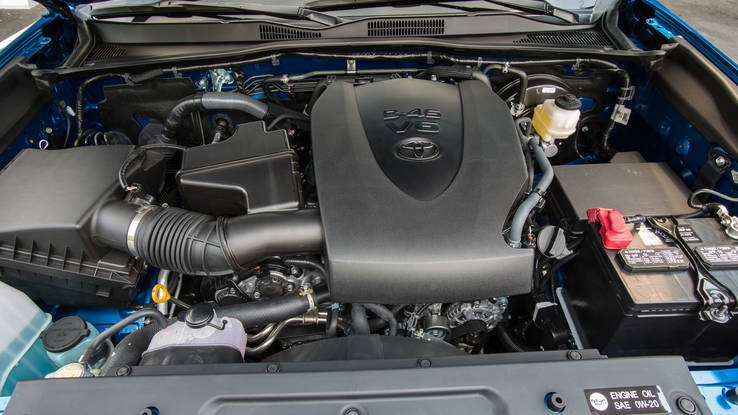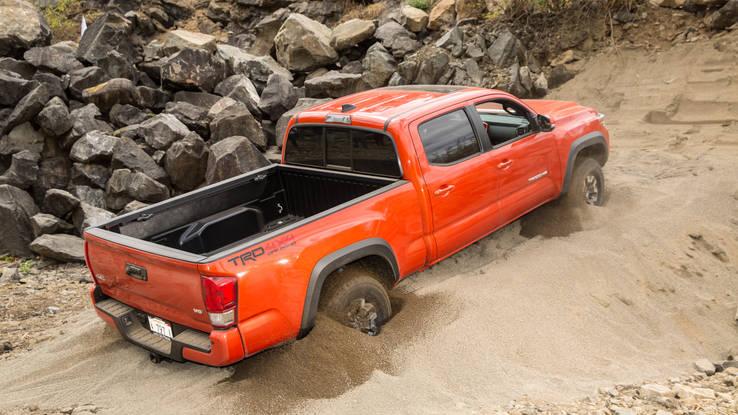Muscled up to maintain midsize dominance
What is it?
Toyota owns the midsize truck segment. It’s not even close. Half of all small pickups have a Tacoma badge on the tailgate. In fact, even with General Motors’ recent onslaught, Tacoma sales are up 20 percent in the first seven months of ’15. Strong. And that’s the old model. So a new, fully modernized one should be an easy sell to this crowd.
“Our goal was to build a truck that is badass,” says Tacoma and Tundra chief engineer Mike Sweers. That’s because “badass” is exactly what Tacoma-driving dudes are after. Sweers says Toyota has the youngest buyers in the segment. They are also loyal to a fault and didn’t want the new truck to stray too far from the outgoing one.
No surprise then, the 2016 Tacoma looks like a muscled version of the 2015 model. In many ways, it is. Dimensionally they’re the same. Unlike just about every redesigned vehicle, the Tacoma hasn’t been supersized. This is good.
The new truck uses the same basic ladder frame as the old one, but enhancements ahead of the B-pillar help it meet today’s — and future — safety regs. Inside and out, cabs are the same size as the outgoing Tacoma too, while the structure uses more ultra-high-strength steels to meet roof-crush safety legislation. Toyota has added several new seals, silencers and mufflers to nearly every surface in and around the cab to combat noise. Sweers says it improves NVH a whopping 43 percent.
Since the frame is somewhat carried over, the front and rear suspension designs aren’t new. The springs and shocks have the same wheel travel but are re-tuned. There are now tougher high-strength steel lower front control arms. You won’t have to pay for 4WD to get the look: All Tacomas ride on the taller 4×4 truck’s suspension and have the same 9.4 inches of ground clearance.
“We left all the [suspension] connection points the same because our customers spend between $ 3,000 and $ 8,000 on aftermarket parts,” says Sweers. “So that (aftermarket) industry said to us, ‘Please don’t change what we’re selling.’” Even aftermarket rear bumpers designed for the old truck bolt on the ’16.
So most of the old Tacoma’s chassis remains, but nearly the entire drivetrain is new. The coarse 236 hp 4.0-liter V6 is gone; a techy new 3.5-liter V6 replaces it, delivering 278 hp through both port and direct injection. This engine also packs Toyota’s most advanced variable valve timing systems, VVT-iW, allowing the V6 to at times run in the more-efficient Atkinson cycle. Most customers will opt for the V6 and its two new six-speed transmissions, an automatic and a manual. A direct-injected 159 hp 2.7-liter four-cylinder from the last truck is the base engine on lower-level SR and SR5 models. No matter the engine, fuel economy increases slightly on all Tacomas. Automatic V6 4WD trucks improve EPA ratings 2 mpg in each category to 18 mpg city/23 mpg highway. A Chevy Colorado equipped the same way gets 17 mpg city/24 highway.
Half of all Tacoma owners get their trucks dirty, so special attention is focused on the 4WD hardware. The new transfer case is lighter and quicker shifting, co-developed with the team working on Toyota’s overseas 4WD workhorse — the commercial-grade HiLux pickup. A beefy new 8.7-inch rear axle comes on TRD trucks, replacing the standard 8-inch axle, also shared with the HiLux. It includes a better-waterproofed and more durable electronic locking differential. And thanks in part to that new axle, the beefiest Tacomas can handle a 6,800-pound trailer (up 300 pounds) and haul a 1,620-pound payload (up 120 pounds).
Last year, Toyota expunged the old-school regular cab from the Tacoma’s lineup because nobody was buying them. Small and cheap isn’t really what midsize buyers are looking for anymore — the lowest SR grade only represents about 6 percent of all Tacomas. Instead a greater percentage are SR5s in both Access and Double Cab in short- (5-foot) or long- (6-foot) bed configurations. And half of all Tacomas wear a TRD sticker on their flanks split between the hardest-core TRD Off Road package and more-athletic TRD Sport. The top sliver opt for the new leather-trimmed Limited with push-button start, dual-zone climate control, a power moonroof and tech like blind-spot monitoring and rear cross-traffic alert. No matter the trim level, all Tacomas have standard Go Pro mount on the windshield. Dude! And the new, deeper cargo beds wear a standard interior rail system with adjustable cleats. Both a smart lockable hard tonneau cover and an interior bedside power outlet are optional.

2016 Toyota Tacoma Limited Photo by Toyota
What’s it like to drive?
If you’ve spent time in a Tacoma, the new one’s outward view and seating position will feel familiar, but the interior is modern, fresh and lightyears ahead of the old truck. Though the cab isn’t any larger, engineers carved out more hip and shoulder space, so it feels a little roomier.
As eager as we were to sample a truck with the new six-speed manual, every test truck on hand was V6-powered and hitched to an automatic transmission. The good news? This powertrain is terrific. The old V6 had torque aplenty down low, but would run out of breath as engine speed climbed. The new V6 is smooth, pulls strongly to redline and sounds much sweeter. Move the cool console shifter over to “sport” and it locks out fifth and sixth gear and really wakes up the trans. We don’t have hard acceleration times, but the new Tacoma feels noticeably quicker than the old one.
Oddly, Toyota retained the rear drum brakes. They say one main reason is Tacoma owners don’t tow frequently enough to need disc-brake performance. Still it seems like a cheap move to have drum brakes on a 2016 truck with a top-trim level approaching $ 40K. Regardless of those drums, the truck’s braking power felt acceptable on our drive.
Though this truck rides on a relatively tall suspension, it feels composed in the corners. That’s especially true of the firmer TRD Sport model. It’s also quiet, making the Tacoma easy to live with.
Since so many Tacoma owners venture off-road, we tested it over rutted, bumpy and dusty forest roads on private land in Black Diamond, Wash., about 40 miles from Seattle. The TRD Off-Road trucks with their fatter 16-inch tires and Bilstein shocks were the best at filtering out both small and larger bumps. So good, you end up driving harder just to see if the suspension can take the abuse. We can confirm — it can.
Toyota set up some rather elaborate slow-speed off-road exercises to showcase the talents of the top dog TRD Off Road model. On Automatic transmission trucks, the package comes with Crawl Control, a five position off-road cruise control system borrowed from the Land Cruiser and 4Runner. We used it on the hardest sections, and because it operates the throttle and brakes for you, it takes all the white-knuckle anxiety out of four-wheeling. Just remember to steer. The trucks also have Multi-Terrain Select, and like systems in more-expensive SUVS, it calibrates the traction and stability control to the terrain, more wheel speed in say “mud and sand” mode, and more traction intervention in “rock” mode. It all adds to the Tacoma’s ease and elegance at negotiating a tough rocky climb. So good in fact, we never needed to lock that rear diff.

2016 Toyota Tacoma TRD Off-Road Photo by Toyota
Do I want it?
The new Tacoma is quicker, quieter and more comfortable than the old one. So in practical terms, it’s a better truck and should have a good chance fending off all the new midsize competition. The TRD Off-Road package is the model that moves our soul. Even if you never point your Tacoma towards a dirt trail, there’s something cool or yes, even badass, about driving a Tacoma with the TRD package. No other midsize truck looks as tough or has quite this level of off-road capability. We’ll take ours painted Inferno orange, please.




























